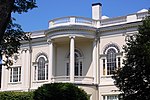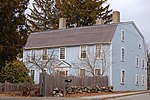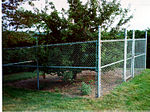Rebecca Nurse Homestead
1678 establishments in the Massachusetts Bay ColonyHistoric house museums in MassachusettsHouses completed in 1678Houses in Danvers, MassachusettsMuseums in Danvers, Massachusetts ... and 2 more
National Register of Historic Places in Essex County, MassachusettsSalem witch trials

The Rebecca Nurse Homestead is a historic colonial house built ca. 1678 located at 149 Pine Street, Danvers, Massachusetts. It had many additions through the years, eventually being historically restored and turned into a museum in 1909. Today it is owned and operated by the Danvers Alarm List Company, a volunteer non-profit organization of Revolutionary War reenactors, and is part of the Salem Village Historic District.
Excerpt from the Wikipedia article Rebecca Nurse Homestead (License: CC BY-SA 3.0, Authors, Images).Rebecca Nurse Homestead
Pine Street, Danvers
Geographical coordinates (GPS) Address Nearby Places Show on map
Geographical coordinates (GPS)
| Latitude | Longitude |
|---|---|
| N 42.5582 ° | E -70.9504 ° |
Address
Rebecca Nurse Homestead
Pine Street 149
01923 Danvers
Massachusetts, United States
Open on Google Maps











